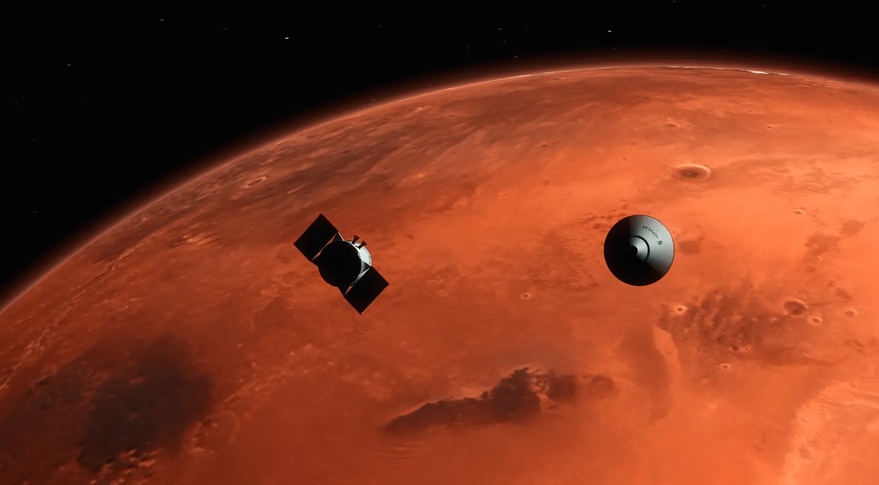WASHINGTON — Two startups, each yet to fly their first missions, said July 19 they are collaborating on a Mars lander mission they claim could launch as soon as 2024.
Launch vehicle startup Relativity Space and in-space transportation company Impulse Space jointly announced July 19 they are working on a robotic Mars lander they anticipate launching as soon as the late 2024 window for missions from Earth to Mars.
Impulse would be responsible for building the lander itself as well as the cruise stage and entry capsule. Relativity would launch the spacecraft on the Terran R reusable rocket it is developing.
“This is a monumental challenge, but one that successfully achieved will expand the possibilities for human experience in our lifetime across two planets,” Tim Ellis, chief executive of Relativity, said in a statement. “With the delivery capabilities of Terran R coupled with Impulse’s in-space transportation, we are bringing humanity one step closer to making Mars a reality.”
The companies offered few technical details about the design of the lander, such as its size and mass. The design of the lander, illustrated on Impulse’s website, is similar to past NASA missions, with a lander encapsuled in an entry capsule with a cruise stage attached to handle operations while traveling for more than six months from Earth to Mars. Upon arrival at Mars, the cruise stage would detach and a heat shield would slow down the capsule as it enters the Martian atmosphere. The heat shield would then detach and parachutes deploy to further slow the lander, which then uses thrusters for a soft landing.
The lander, the companies said, will carry payloads “supporting the research and development needed to build toward humanity’s multiplanetary future.” The companies did not disclose the payloads or the payload capacity of the lander.
In a written response to questions, the companies said they envision the lander carrying payloads for government and commercial customers, providing services similar to those by companies developing lunar landers that have won business through NASA’s Commercial Lunar Payload Services program.
The companies, in that response, declined to provide an estimated cost of the mission. “We can say that the overall estimated cost of the mission is significantly less than previous Mars missions. By building on the work NASA JPL has done, we’re able to take those learnings and commercialize missions at a lower cost.”
The most recent static Mars lander mission run by NASA’s Jet Propulsion Laboratory, the Insight mission, cost the agency $814 million, including launch but not including major instruments contributed by international partners. That lander used a design that was based on previous missions, like the Phoenix lander, to reduce development costs.
Only NASA and China’s space program have successfully landed and operated spacecraft on Mars. NASA has flown a series of landers from the two Viking landers in 1976 to the Perseverance rover that landed last year. China was successful in its first Mars landing attempt on the Tianwen-1 mission last year.
The former Soviet Union’s Mars 3 spacecraft appeared to land successfully on Mars in 1971, but contact was lost less than two minutes after landing and never restored. Beagle 2, a small British lander that flew to Mars in 2003 as a rideshare payload on the European Space Agency’s Mars Express orbiter, never made contact after landing. Images later showed the lander made it to the surface intact but failed to deploy two of its four solar panels and communications antenna.
In 2016, SpaceX announced a proposed “Red Dragon” Mars landing mission launching as soon as 2018 using a version of its Dragon 2 spacecraft it was developing for NASA’s commercial crew program. That mission has NASA support through an unfunded Space Act Agreement that would give the agency access to data from the spacecraft’s entry, descent and landing.
However, SpaceX dropped plans for Red Dragon a little more than a year later after electing not to pursue propulsive landings for the Dragon spacecraft. By that time the mission’s launch had already slipped to at least 2020.
SpaceX is now pursuing Mars missions through its Starship vehicle. In a 2017 presentation at the International Astronautical Congress in Adelaide, Australia, he projected launching the first cargo missions to Mars in 2022, a schedule he acknowledged then was “aspirational.” SpaceX has yet to conduct an orbital launch of its Starship vehicle, let alone one to Mars.
Relativity and Impulse also have yet to conduct any launches. Relativity is testing its smaller Terran 1 rocket at its Cape Canaveral, Florida, launch site for a first launch later this summer, and expects to have the Terran R rocket ready no earlier than 2024. Impulse, which has raised $30 million in seed funding to date, is working on in-space transportation vehicles but has not disclosed details, or a schedule, for its first mission.
In their announcement, Impulse and Relativity appeared to acknowledge the likelihood of delays. The companies said while they were planning a launch in 2024, their exclusive agreement to cooperate on the mission extends to 2029. “With launch windows occurring every two years, extending the agreement to 2029 allows for multiple launch options should we need them,” the companies said in their response to questions.
